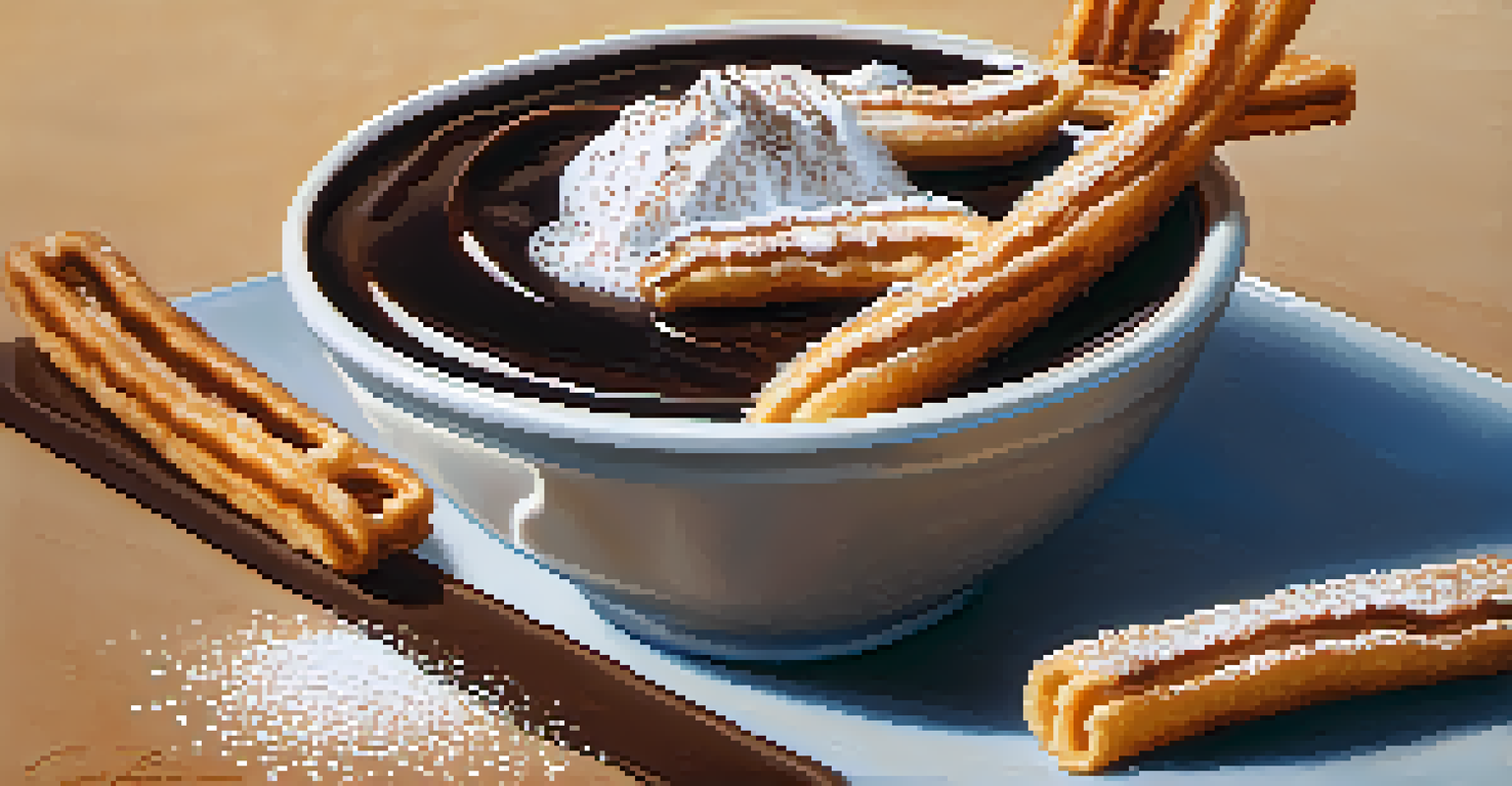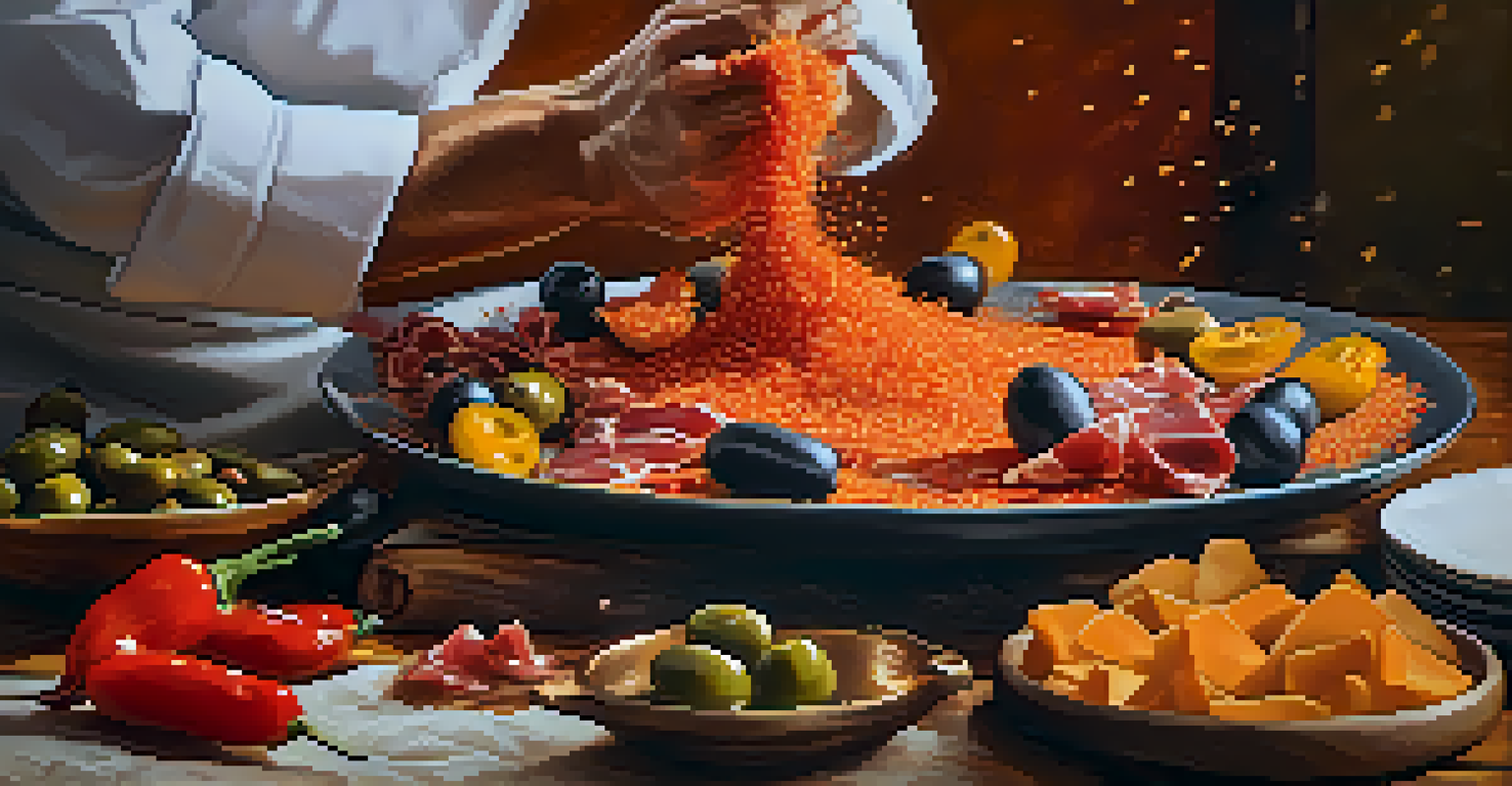Culinary Photography: Capturing the Flavors of Spanish Cuisine

Understanding the Essence of Spanish Cuisine
Spanish cuisine is a vibrant tapestry woven from diverse regional flavors, traditions, and ingredients. From the rich paellas of Valencia to the spicy tapas of Andalusia, each dish tells a story of its origin. Understanding these culinary narratives is crucial for a photographer aiming to capture their essence authentically.
Food is our common ground, a universal experience.
The key to great culinary photography lies in showcasing not just the food but the culture behind it. This means digging into the history of ingredients, the significance of traditional cooking methods, and the communal experience of sharing meals. When photographers appreciate these elements, their images resonate more deeply with viewers.
By immersing yourself in the essence of Spanish cuisine, you can translate that passion into your photography. Think of each dish as a canvas, where colors, textures, and components come together to create a masterpiece that not only looks appealing but also evokes the flavors and aromas of Spain.
The Importance of Lighting in Food Photography
Lighting is the lifeblood of food photography, especially when capturing the vibrant colors of Spanish dishes. Natural light is often preferred, as it highlights the intricate details and rich textures of the food. A well-lit photo can make a simple plate of patatas bravas look like a work of art.

When photographing Spanish cuisine, consider the time of day and the direction of light. Early morning or late afternoon often provides the soft, golden light that enhances the warmth of dishes. Experimenting with light sources, such as diffusers or reflectors, can also help you achieve that perfect glow.
Cultural Context is Key
Understanding the cultural narratives behind Spanish cuisine enhances both culinary photography and viewer connection.
Ultimately, the right lighting allows you to create atmosphere, mood, and depth in your culinary shots. It’s like painting with light, where each dish becomes a vibrant expression of Spanish culture, inviting viewers to taste with their eyes.
Choosing the Right Props and Backgrounds
The right props and backgrounds can elevate your food photography to new heights. When capturing the essence of Spanish cuisine, think about incorporating traditional elements such as rustic tableware or vibrant textiles. These props can enhance the story behind the dish, giving viewers context and connection.
A recipe has no soul. You, as the cook, must bring soul to the recipe.
Consider colors and textures that complement the food. For example, a bold blue plate can beautifully contrast with the bright reds and yellows of a gazpacho. Alternatively, a wooden table can evoke a homely, rustic feel that aligns with authentic Spanish dining experiences.
The goal is to create a harmonious composition that draws attention to the food while also enriching the overall visual narrative. By thoughtfully selecting your props and backgrounds, you can transform a simple dish into a memorable visual feast.
Capturing Textures: The Key to Flavor
Textures play a pivotal role in culinary photography, particularly in Spanish cuisine where freshness and quality are paramount. Capturing the crispy edges of a churro or the creamy layers of a flan can evoke a sensory experience for your audience. It’s all about making them want to reach through the screen and take a bite.
To effectively capture these textures, consider using close-up shots. A macro lens can help you focus on fine details, allowing the viewer to appreciate the intricacies of each ingredient. Experiment with angles that highlight the dish's unique characteristics, whether it’s the bubbling cheese on a tortilla or the flaky pastry of a seafood empanada.
Lighting Sets the Mood
Natural lighting is essential in food photography, as it highlights the vibrant colors and textures of Spanish dishes.
Ultimately, showcasing textures not only enhances the visual appeal but also communicates the flavors and sensations associated with each dish. This approach adds depth to your images, making them more enticing and relatable.
Incorporating Action Shots for Dynamic Storytelling
Action shots bring life and movement to your culinary photography, particularly when portraying the vibrant culture of Spain. Capturing the moment a chef sprinkles paprika over a dish or a diner reaching for a tapas plate adds an engaging narrative element. These images create a story that invites viewers to experience the meal beyond just its appearance.
When planning for action shots, think about the moments that define Spanish dining culture. Consider capturing the communal experience of sharing food, such as clinking glasses during a toast or passing dishes around a table. These candid moments can evoke emotions and connect viewers to the joy of dining.
Incorporating action shots into your photography not only enhances visual interest but also emphasizes the cultural significance of Spanish cuisine. It’s about creating a dynamic experience that transports your audience to the heart of a lively Spanish meal.
Post-Processing Techniques to Enhance Your Images
Post-processing is an essential step in food photography, allowing you to enhance the colors and clarity of your images. Using software like Adobe Lightroom or Photoshop, you can adjust brightness, contrast, and saturation to make your Spanish dishes pop. This can be especially useful for emphasizing the vibrant colors found in dishes like pisto or ensalada.
However, it’s important to maintain a natural look. Over-editing can lead to unrealistic representations of food, which might deter viewers. Aim for a balance where your images are enhanced but still authentic to the dish’s true appearance.
Engage with Action Shots
Incorporating action shots into your photography brings life to the images and tells a dynamic story of Spanish dining culture.
Post-processing is like adding the final seasoning to a dish—just enough to elevate it without overpowering the original flavors. This careful attention to detail can make your culinary photography truly shine.
Sharing Your Culinary Creations Online
Once you’ve captured stunning images of Spanish cuisine, it’s time to share them with the world. Social media platforms like Instagram and Pinterest are ideal for showcasing your culinary photography. Use relevant hashtags, like #SpanishCuisine or #FoodPhotography, to reach a wider audience and connect with fellow food lovers.
Consider creating engaging captions that tell the story behind each dish. Share insights about the ingredients, the cooking process, or a personal anecdote related to the food. This not only adds depth to your posts but also invites your audience to connect with your culinary journey.

Engagement is key in the digital world; interact with your followers by responding to comments and asking questions. Building a community around your culinary photography can lead to new opportunities, collaborations, and a shared love for the flavors of Spain.